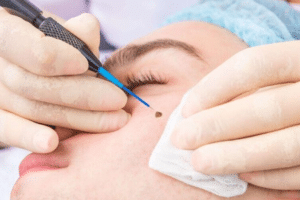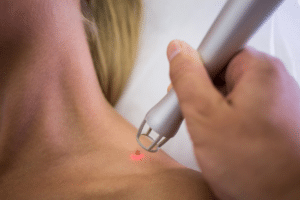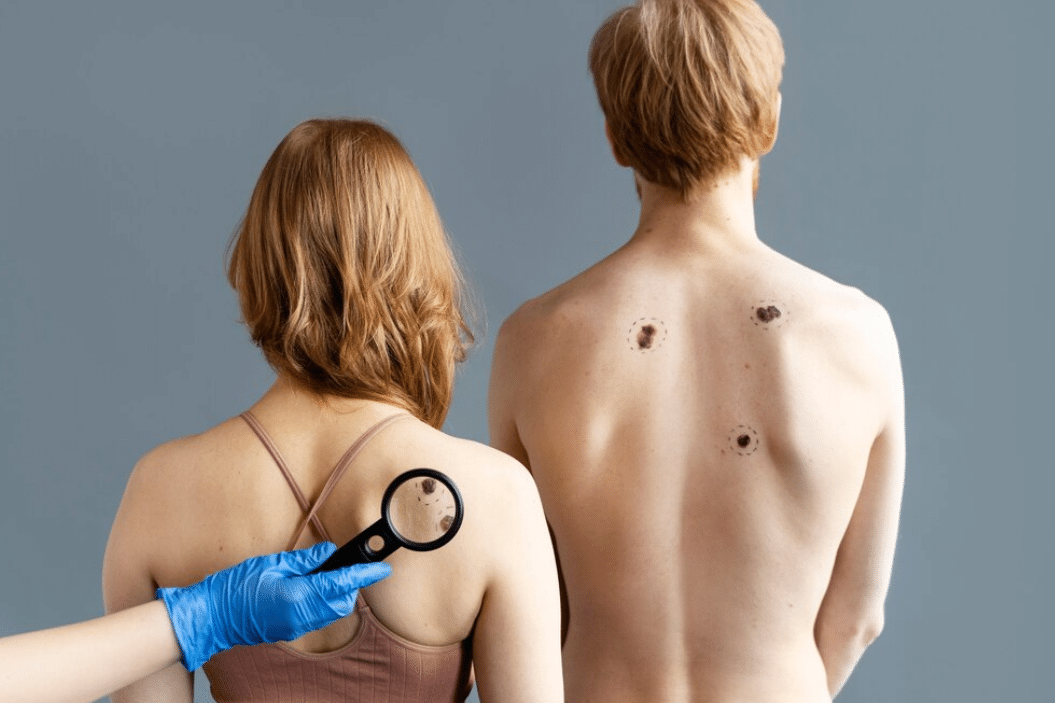Warts are common skin growths caused by the human papillomavirus (HPV). While generally harmless, they can be bothersome, painful, and affect your confidence. This blog provides comprehensive information on warts, including their identification, causes, types, wart removal treatment options, and prevention tips.
What are Warts?

How to Identify Warts
Warts vary in appearance depending on the type and location. They can grow as single bumps or in clusters. Key characteristics to look for include:
- Raised or flat growths: Warts can be raised with a rough surface or flat and smooth.
- Color: They may be skin-colored, yellowish, brownish, or grayish-black.
- Location: Warts can appear on any part of the body, but are most common on the hands, feet, face, and neck.
- Texture: Typically, warts have a rough, hard texture, though some may be smooth.
- Clotted blood vessels: Small, darkened spots may be visible in some warts due to clotted blood vessels.
If you’re unsure whether a skin growth is a wart, consult a healthcare provider for proper diagnosis. In rare cases, a skin biopsy may be necessary to confirm the diagnosis.
Causes and Risk Factors
Warts are caused by different strains of HPV, with over 100 types identified. The virus enters the skin through small cuts or breaks. Risk factors that increase the likelihood of developing warts include:
- Skin injuries: Any damage to the skin can provide an entry point for HPV.
- Skin infections: Existing skin infections can compromise the skin’s barrier, making it easier for HPV to infect.
- Moist skin: HPV is more likely to infect skin that is frequently wet or damaged.
- Hyperhidrosis: Excessive sweating can create a moist environment conducive to HPV infection.
- Public swimming pools: Exposure to HPV can occur in public swimming areas.
- Nail biting: This habit can cause breaks in the skin around the nails, increasing the risk of infection.
- Direct contact: Touching a wart on another person or on yourself can spread the virus.
- Shaving: Can spread the virus.
- Weakened immune system: A compromised immune system may make you more susceptible to HPV infection.
Types of Warts
Different HPV strains cause different types of warts, each with distinct characteristics. Here are some common types:
- Common Warts (Verruca Vulgaris): These have a firm, raised, rough surface and often appear cauliflower-like. They commonly occur on the fingers, near the nails, and on areas with broken skin.
- Plantar Warts (Verruca Plantaris): These develop on the soles of the feet and can be painful due to the pressure from walking. They often have a flat appearance and may have black dots on the surface. For warts on feet treatment, various methods can be employed to alleviate discomfort and remove the wart.
- Plane Warts (Verruca Plana): Also known as flat warts, these are round, flat, and smooth. They are typically skin-colored, yellowish, or brownish and tend to grow in large numbers, often on the face, lower legs, and hands.
- Filiform Warts (Verruca Filiformis): These are long, thin, and thread-like, often appearing on the face, neck, and eyelids.
- Periungual Warts: These develop under and around the fingernails and toenails. They can be painful and affect nail growth.
- Mosaic Warts: These grow in tightly clustered groups, forming a tile-like pattern. They commonly appear on the palms of the hands and soles of the feet.
Treatment Options

Manas Aesthetics offers several effective wart removal treatment options.
- Salicylic Acid: This over-the-counter medication is available in various forms, such as creams, gels, and pads. It works by gradually dissolving the wart tissue. Regular application is necessary, and it can take several weeks to months to see results.
- Laser Treatment: Laser therapy can be used to destroy the wart tissue. It’s a precise method that can be effective for stubborn warts.
Manas Aesthetics offers expert skin wart removal services tailored to your specific needs. Our skilled professionals use advanced techniques to ensure effective and safe wart removal treatment.
Prevention Tips
While it’s not always possible to prevent warts, these tips can reduce your risk of infection and spread:
- Avoid touching warts: Refrain from touching warts on yourself or others.
- Wash hands frequently: Regular handwashing can help prevent the spread of HPV.
- Keep skin dry: Dry your hands and feet thoroughly, especially after swimming or showering.
- Wear shower shoes: Use shower shoes or sandals in public showers and locker rooms.
- Avoid sharing personal items: Do not share towels, razors, or nail clippers.
- Cover cuts and scrapes: Keep any breaks in the skin clean and covered.
- Avoid biting nails: This can create openings for HPV to enter the skin.
- Maintain a healthy immune system: A strong immune system can help fight off HPV infections.
- Be cautious in public places: Wear appropriate footwear in communal areas to avoid contracting the virus that causes plantar warts.
To Sum Up
Warts are a common skin condition caused by HPV. Understanding their identification, causes, types, and wart removal treatment options can help you manage and prevent them. If you have concerns about warts or are seeking effective wart removal treatment, consult the experts at Manas Aesthetics.
We offer personalized solutions for skin wart removal, including specialized neck wart removal and warts on feet treatment. Our goal is to provide safe, effective, and professional care to help you achieve clear, healthy skin. Remember, proper hygiene and preventive measures are key to minimizing the risk of wart infections. And while some may seek a wart remover for skin tags, it’s always best to consult with professionals to ensure the wart removal treatment is appropriate for your specific skin condition.

